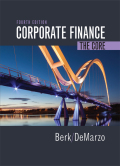
EBK CORPORATE FINANCE
4th Edition
ISBN: 8220103164535
Author: DeMarzo
Publisher: PEARSON
expand_more
expand_more
format_list_bulleted
Question
Chapter 19, Problem 11P
Summary Introduction
To determine: The unlevered cost of capital.
Introduction:
The
Expert Solution & Answer
Want to see the full answer?
Check out a sample textbook solution
Students have asked these similar questions
Need soln for this
Muskoka Tourism has announced a rights offer to raise $30 million for a new magazine, titled ‘Discover Muskoka’. The magazine will review potential articles after the author pays a nonrefundable reviewing fee of $5,000 per page. The stock currently sells for $52 per share and there are 3.9 million shares outstanding.
Required
What is the maximum possible subscription price? What is the minimum?
If the subscription price is set at $46 per share, how many shares must be sold? How many rights will it take to buy one share?
What is the ex-rights price? What is the value of a right?
Northern Escapes Inc. has 225,000 shares of stock outstanding. Each share is worth $73, so the company’s market value of equity is $16,425,000. Suppose the firm issues 30,000 new shares at the following prices: $73, $69, and $60. What will the effect be of each of these alternative offering prices on the existing price per share?
Chapter 19 Solutions
EBK CORPORATE FINANCE
Ch. 19.1 - Prob. 1CCCh. 19.1 - Prob. 2CCCh. 19.2 - Prob. 1CCCh. 19.2 - Prob. 2CCCh. 19.3 - What is a pro forma income statement?Ch. 19.3 - Prob. 2CCCh. 19.4 - Prob. 1CCCh. 19.4 - Prob. 2CCCh. 19.5 - Prob. 1CCCh. 19.5 - Prob. 2CC
Ch. 19.6 - Prob. 1CCCh. 19.6 - Prob. 2CCCh. 19 - Prob. 1PCh. 19 - Prob. 2PCh. 19 - Prob. 3PCh. 19 - Prob. 4PCh. 19 - Under the assumptions that Idekos market share...Ch. 19 - Prob. 6PCh. 19 - Prob. 7PCh. 19 - Prob. 8PCh. 19 - Prob. 11PCh. 19 - Calculate Idekos unlevered cost of capital when...Ch. 19 - Using the information produced in the income...Ch. 19 - How does the assumption on future improvements in...Ch. 19 - Approximately what expected future long-run growth...Ch. 19 - Prob. 16P
Knowledge Booster
Similar questions
- Need answer correctly.arrow_forwardMuskoka Tourism has announced a rights offer to raise $30 million for a new magazine, titled ‘Discover Muskoka’. The magazine will review potential articles after the author pays a nonrefundable reviewing fee of $5,000 per page. The stock currently sells for $52 per share and there are 3.9 million shares outstanding.arrow_forwardSs stores probarrow_forward
- Henrietta’s Pine Bakery Corporation would like to raise $75 million to finance its expansion into new markets. The company will sell new shares of equity via a general cash offering to raise the needed funds. If the offer price is $15 per share and the company’s underwriters charge a 6% spread, how many shares need to be sold?arrow_forwardNeed soln for this qnarrow_forwardSolve himlto problemarrow_forward
arrow_back_ios
SEE MORE QUESTIONS
arrow_forward_ios
Recommended textbooks for you
- Principles of Accounting Volume 2AccountingISBN:9781947172609Author:OpenStaxPublisher:OpenStax College
 Intermediate Financial Management (MindTap Course...FinanceISBN:9781337395083Author:Eugene F. Brigham, Phillip R. DavesPublisher:Cengage Learning
Intermediate Financial Management (MindTap Course...FinanceISBN:9781337395083Author:Eugene F. Brigham, Phillip R. DavesPublisher:Cengage Learning

Principles of Accounting Volume 2
Accounting
ISBN:9781947172609
Author:OpenStax
Publisher:OpenStax College

Intermediate Financial Management (MindTap Course...
Finance
ISBN:9781337395083
Author:Eugene F. Brigham, Phillip R. Daves
Publisher:Cengage Learning